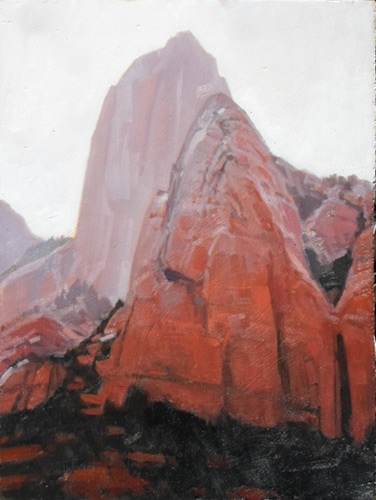In this series of articles, Utah artist J. Brad Holt talks about what artists are seeing as they look at the landscape. Holt studied geology in college and is attentive to what the rocks suggest in the scenes he paints.
Lead Image: “Cedar Breaks — Into the Bowl VI,” by J. Brad Holt, 2015, oil, 12 x 16 in. Studio painting
Last time I talked about the methods by which geologists obtain both relative and numerical dates for rock strata. Today I would like to show how that dating information is organized into commonly accepted geological time scales. These scales operate as a reference tool among geologists, as well as those outside the science, helping to place historical geophysical material and events in context, and they provide a means of getting a handle on the unimaginable antiquity of the earth. The geological time scale was created by geologists in Western Europe in the 19th century, using relative dating methods. Radiometric dating methods in the 20th century allowed numerical dates to be plugged into the time scale, which was in common use by then.
The earth is generally considered to be about 4.5 billion years old. That is accepted as the point at which the heat of the proto-planet had dissipated sufficiently to allow the crust to completely solidify and out-gassing resulted in the formation of atmosphere and oceans. This is the point at which the geological time scale begins. The scale is organized into eons, eras, periods, and epochs. The entire history of the earth from 4.5 billion years ago until 542 million years ago is known as the Precambrian. However, the Precambrian is generally divided into the Archean Eon (4.5 million years ago to 2.5 billion years ago), and the Proterozoic Eon (2.5 billion to 542 million years ago). The period from 542 million years ago to the present is called the Phanerozoic Eon.

The Phanerozoic Eon is divided into three eras: the Paleozoic Era (542 million years ago to 251 million years ago), the Mesozoic Era (251 million years ago to 65.5 million years ago), and the Cenozoic Era (65.5 million years ago to present). The Paleozoic Era is divided into six periods: the Cambrian (542 million years ago to 488 million years ago), the Ordovician (488 million years ago to 444 million years ago), the Silurian (444 million years ago to 416 million years ago), the Devonian (416 million years ago to 359 million years ago), and the Carboniferous (359 million years ago to 299 million years ago). (Sometimes this period is divided into the Mississippian and the Pennsylvanian.) Finally comes the Permian (299 million years ago to 251 million years ago). The Cambrian, Ordovician, Silurian, and Devonian periods are named for regions in England and Wales. The Carboniferous is named for coal deposits in Europe and America, and the Permian for the Perm region in Russia. The Paleozoic Era begins with the Cambrian explosion in which life began to proliferate, and it ends with the Permian extinction.

The Mesozoic Era is divided into three periods: The Triassic (251 million years ago to 199.6 million years ago), the Jurassic (199.6 million years ago to 145.5 million years ago), and the Cretaceous (145.5 million years ago to 65.5 million years ago). The Triassic Period is named for the distinctive three-layered appearance these strata show in parts of central Europe. Jurassic is from the Jura mountains in Switzerland. The Cretaceous gets its name from prominent European chalk deposits of that age. The Mesozoic Era is the age of the dinosaurs. In the plant kingdom, the era begins with gymnosperms dominant. By the end of the Cretaceous, the angiosperms were firmly established.
The Cenozoic Era is comprised of two periods: the Tertiary (65.5 million years ago to 1.8 million years ago), and the Quaternary (1.8 million years ago to present). More often, the Cenozoic is divided into seven epochs: the Paleocene (65.5 million years ago to 55.8 million years ago), the Eocene (55.8 million years ago to 33.9 million years ago), the Oligocene (33.9 million years ago to 23 million years ago), the Miocene (23 million years ago to 5.3 million years ago), the Pliocene (5.3 million years ago to 1.8 million years ago), the Pleistocene (1.8 million years ago to 0.01 million years ago), and finally, the Holocene, which is our present epoch. The Cenozoic Era begins with the Cretaceous extinction, and ends with the development of our own species. I like to refer to the Holocene Epoch as “The Age of Artists,” but the scientific community seems hesitant to adopt this terminology.





As a former mine surveyor I always look at landforms described by the rocks underneath and subsequent erosion.
Great revision from my text book years!